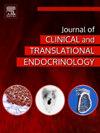低血糖诊断中与内源性高胰岛素血症相关的变量。低危患者的72小时禁食试验是否可以缩短?
IF 3.3
Q1 ENDOCRINOLOGY & METABOLISM
Journal of Clinical and Translational Endocrinology
Pub Date : 2025-03-07
DOI:10.1016/j.jcte.2025.100386
引用次数: 0
摘要
背景:72小时空腹试验仍然是诊断内源性高胰岛素血症的标准。我们研究了哪些变量可以识别内源性高胰岛素血症的低风险患者,在这些患者中可以考虑缩短72小时禁食试验。方法本多中心回顾性研究纳入64例无糖尿病患者(46例女性,中位年龄45岁),接受72小时空腹试验诊断低血糖。收集了测试前和测试内的变量,包括测试期间的即时血糖轨迹。如果出现症状性血糖≤55 mg/dL或无症状性血糖≤45 mg/dL,则在72 h前停止检测。内源性高胰岛素血症的诊断标准为血清葡萄糖≥55 mg/dL,血清胰岛素≥3.0 μU/mL,血清c肽≥0.6 ng/mL。结果内源性高胰岛素血症患者(n = 10)的护理点血糖下降轨迹更陡峭(p <;0.001)。年龄较大和最低试验前血清葡萄糖浓度较低与内源性高胰岛素血症独立相关。我们开发了一个包括这些变量和性别在内的内源性高胰岛素血症概率预测计算器(AUC = 0.94)。年龄较大、女性、较低的身体质量指数和禁食前24小时最低护理点血糖与禁食前24小时后的血清葡萄糖- 55 mg/dL独立相关。我们开发了一个预测空腹24小时后血清葡萄糖≤55 mg/dL概率的计算器,其中包括这些变量(AUC = 0.84)。结论spre和试验内变量可以识别内源性高胰岛素血症的低风险个体,可以考虑缩短72小时禁食试验。本文章由计算机程序翻译,如有差异,请以英文原文为准。
Variables associated with endogenous hyperinsulinism in hypoglycemia diagnosis. Could the 72-hour fasting test be shortened in low-risk patients?
Background
The 72-hour fasting test remains the standard for the diagnosis of endogenous hyperinsulinism. We investigated which variables could identify patients at low risk for endogenous hyperinsulinism, in whom a shortening of the 72-hour fasting test could be considered.
Methods
This multicenter, retrospective study included 64 individuals (46 women, median age 45 years) without diabetes who underwent 72-hour fasting tests for the etiologic diagnosis of hypoglycemia. Pre- and intra-test variables were collected, including point-of-care glucose trajectories during the test. Testing was stopped before 72 h if symptomatic serum glucose <55 mg/dL or asymptomatic serum glucose ≤45 mg/dL occurred. Endogenous hyperinsulinism was diagnosed in individuals who had serum glucose <55 mg/dL, serum insulin ≥3.0 μU/mL, and serum C-peptide ≥0.6 ng/mL.
Results
Patients with endogenous hyperinsulinism (n = 10) had steeper descending point-of-care glucose trajectories (p < 0.001) than those without it. Older age and lower minimum pre-test serum glucose concentrations were independently associated with endogenous hyperinsulinism. A calculator for probability prediction of endogenous hyperinsulinism was developed including these variables and sex (AUC = 0.94). Older age, female sex, lower body mass index, and lower minimum point-of-care glucose during the first 24 h of fasting were independently associated with serum glucose <55 mg/dL after the first 24 h of fasting. A calculator for predicting probability of serum glucose <55 mg/dL after the first 24 h of fasting was developed including these variables (AUC = 0.84).
Conclusions
Pre- and intra-test variables can identify individuals at low risk for endogenous hyperinsulinism, in whom shortening the 72-hour fasting test could be considered.
求助全文
通过发布文献求助,成功后即可免费获取论文全文。
去求助
来源期刊

Journal of Clinical and Translational Endocrinology
ENDOCRINOLOGY & METABOLISM-
CiteScore
6.10
自引率
0.00%
发文量
24
审稿时长
16 weeks
 求助内容:
求助内容: 应助结果提醒方式:
应助结果提醒方式:


